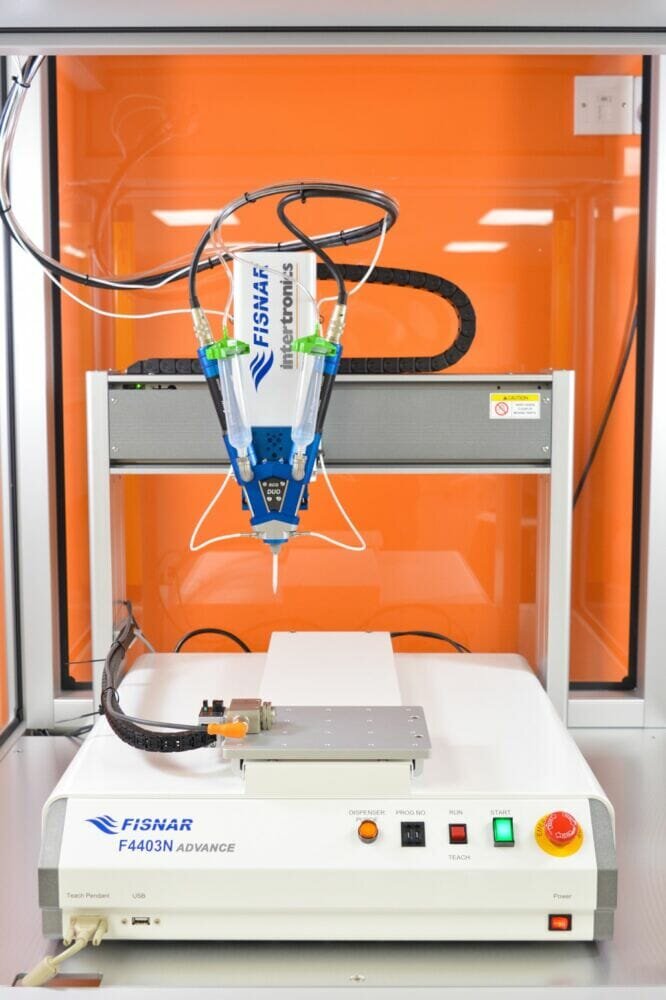~ What to consider when setting up a dispensing application ~
When purchasing dispensing equipment for an adhesives process, part of the decision making will include return on investment (ROI). Here Kevin Cook, Technical Manager at adhesives specialist Intertronics, discusses how ROI can be achieved from an investment in dispensing equipment and automation.
The application of adhesives, coatings, sealants, potting compounds or liquid gaskets might be seen as a necessary evil — the assumption is that it is messy, hard to control and wasteful. Investing in improving the process can banish any preconceptions or bad experiences, and pay off fairly quickly. What are the factors you need to consider when making the purchase decision?
Most of the costs surrounding an adhesives application investment are up front in equipment and training — though some technologies require ongoing consumables and limited maintenance. We find that most installations are a smaller investment than people may think, although the factors determining dispensing ROI range from direct advantages to some indirect and more complex benefits.
The resultant changes to your process in terms of labour, time and resources saved can bring significant value to your business. Dispensing technology can drive improvements in accuracy and repeatability, and therefore quality and yield; choosing the optimal system for your specific application is central to this. So, when investing in technology, it is important to understand exactly what it is you want to achieve with your process — and consider what value that brings to the business in a broad, holistic and long term way.
Establishing your goals
Is it that your process is taking too long and creating too much work in progress (WIP)? Or are you looking to improve quality by dispensing material more accurately? We may suggest a step by step improvement to a process, rather than a complete overhaul; understanding the specific objectives helps to shortlist equipment that might suit the speed, accuracy or repeatability goals you are looking to achieve.
Once you are clear on your objectives you can begin to optimise the process. Gathering information about the entire bonding application means you can come up with possible solutions to evaluate in real life. There is no one size fits all approach, determining which equipment will achieve your goals and deliver ROI requires a good understanding of both the process and the options available.
For example, if there is a problem with positioning accuracy when dispensing material, it may be that using a robot to position your dispensing technology is a good approach to improve quality and yield. A robot could also help a manufacturer looking to improve speed, as they can run continuously without breaks. However, in applications that do not require high levels of accuracy and repeatability, there may not be a clear business case — manual positioning of a more accurate dispensing technology could suffice. Over-specifying process parameters will limit adhesive and equipment choice, and potentially increase your costs, so it is important to be pragmatic in your approach.
Once you have a possible solution, it is essential to evaluate the proposed equipment on production parts in real life, to compare the new process with the existing set up and establish if it can help you achieve your goals. Not everything that works in theory will work in practice, so a real-world trial will ensure the proposed application works as expected. You can evaluate factors including the number of deposited shot sizes, statistical analysis to confirm precision or the minimum and maximum adhesive quantities needed to produce the required bond strength. We find that many customers who visit our Technology Centre leave with a different set up than they had in mind, based on the results of practical tests.
Eliminating hidden costs
The key to understanding ROI is establishing where the hidden costs are and calculating the savings that can be achieved when they are eliminated. As well as the technical benefits, you can weigh up wider factors like how long the equipment will be in use, the volume of parts it will operate on and the start-up and shut-down periods and maintenance activity it will require, for a fuller picture of the potential cost savings.
For example, when switching from an operator manually dispensing using syringes to a simple time pressure dispenser, there may be other benefits aside from the obvious increase in yield and reduction in waste as a result of dispensing more accurately. You may be able to dispense directly from larger packaging, either removing a redundant decanting step or allowing them to purchase material more cost-effectively in larger pails, achieving a time saving that also reduces labour costs. There is a possible health and safety benefit in the removal of repetitive strain injury (RSI), which is a common issue in manual processes.
Assessing this as part of a trial means you could determine how much the process has sped up, how much waste has been reduced by and compare that with the upfront and operational costs of equipment.
Bigger picture
While most of our customers come to us looking for equipment for a specific application, many find multiple applications for the equipment they choose. Using the technology for more than one process can quickly multiply the ROI, as well as reduce the payback period. A dispensing robot, for example, can be fitted with many dispensing, curing and inspection technologies, so the manufacturer may be able to program and use it to dispense multiple materials, or even for other positioning applications on the production line.
As well as considering additional processes, you can assess whether the equipment could cope with larger volumes of products if the business scales up or gets a larger order. Many of our customers have seen success from an approach where they start small with a view to grow later on. Long term, good ROI may be achieved by selecting modular technology that is easy to scale.
Upfront discussions
Many of our customers achieve a payback period of six to 18 months, but sometimes it can be even faster. Your business will have guidelines on the expected maximum payback period, and your investment justification will include tangible and readily measurable cost savings. There may be some intangible or less readily calculated benefits to consider as well, like the prevention of reputational or brand damage from shipping non-optimal products.
Whatever the application, the best approach is always to consult a specialist who can talk you through the available options and test them as a real-life example. A trusted advisor that is honest and open about whether a process requires upgrading or warrants automation, can help you find the right fit, to ensure you don’t over or under invest.
Customers are welcome to visit our Technology Centre in Kidlington, Oxfordshire or consult with us online to experience process development live, as well as obtain full laboratory reports with insights into their process choices. For more information on establishing or improving a dispensing process, call +44 (0) 1865 842842 to speak to a specialist. For more information visit https://www.intertronics.co.uk/.





